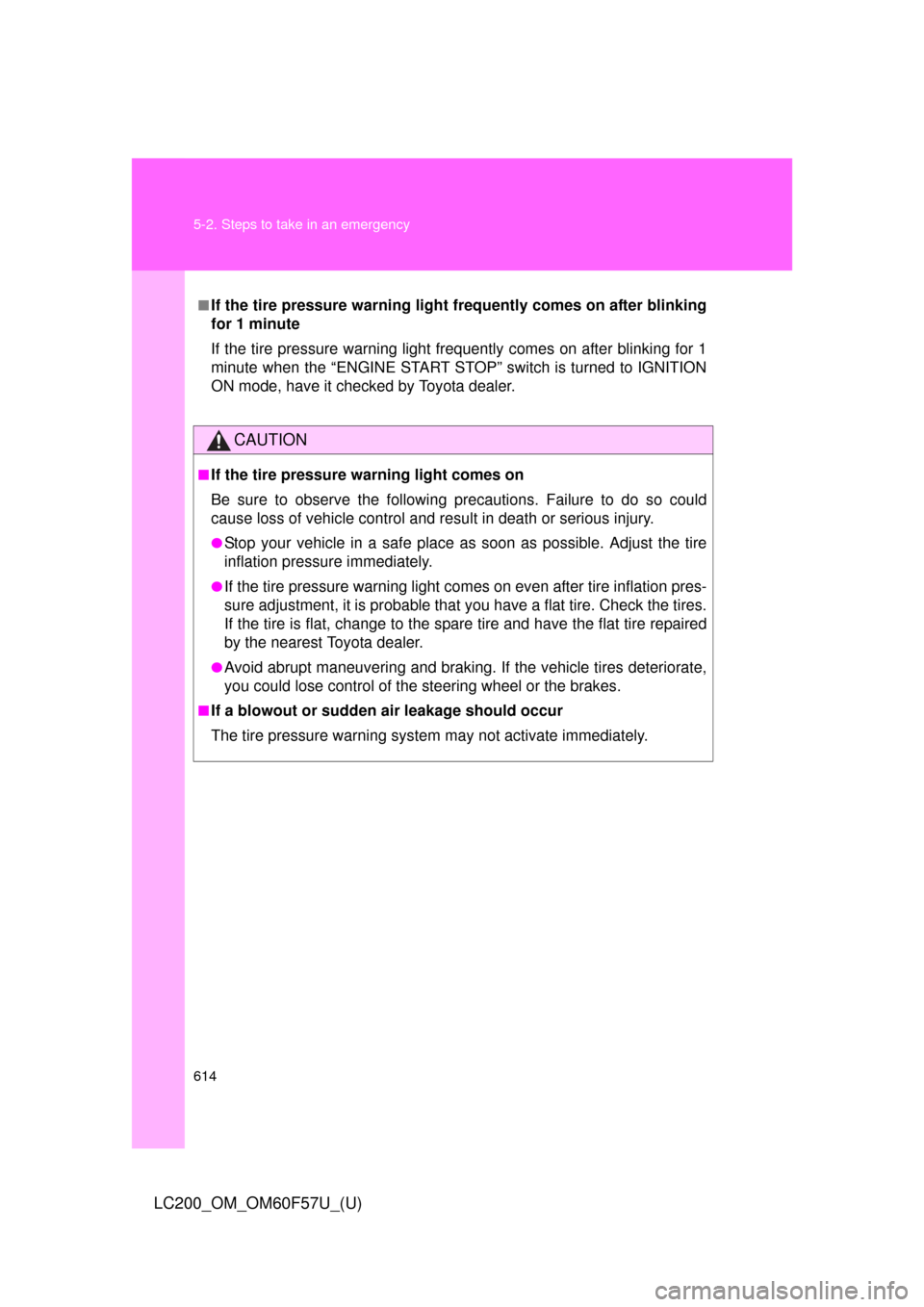Page 612 of 720

612 5-2. Steps to take in an emergency
LC200_OM_OM60F57U_(U)
■SRS warning light
This warning light system monitors the following:
●The airbag sensor assembly
●Front impact sensors
●Side impact sensors (rear)
●Side impact sensors (front door)
●Safing sensor (rear)
●The driver’s seat belt buckle switch
●The driver’s seat position sensor
●Front passenger’s seat belt buckle switch
●The airbags
●The interconnecting wiring and power sources
●The front passenger occupant classification system
●“AIR BAG ON” and “AIR BAG OFF” indicator lights
●The seat belt pretensioners
●The “RSCA OFF” indicator light
■Changing the engine oil
Make sure to reset oil change system
■
When the tire pressure warning light comes on
Check the tire inflation pressure and adjust to the appropriate level.
Pushing the tire pressure warning reset switch does not turn off the tire
pressure warning light.
■The tire pressure warning light may turn on due to natural causes
The tire pressure warning light may turn on due to natural causes such
as natural air leaks or tire inflation pressure changes caused by temper-
ature. In this case, adjusting the tire inflation pressure will turn off the
warning light (after a few minutes).
Page 613 of 720

5
When trouble arises
613 5-2. Steps to take in an emergency
LC200_OM_OM60F57U_(U)
■When a tire is replaced with a spare tire
The spare tire is also equipped with the tire pressure warning valve and
transmitter. The tire pressure warning light will turn on if the tire inflation
pressure of the spare tire is low. If a tire goes flat, even though the flat
tire is replaced with the spare tire, the tire pressure warning light does
not turn off. Replace the spare tire with the repaired tire and adjust the
proper tire inflation pressure. The tire pressure warning light will turn off
after a few minutes.
■If the tire pressure warning system is inoperative
The tire pressure warning system will be disabled in the following condi-
tions:
(When the condition becomes normal, the system will work properly.)
●If tires not equipped with tire pressure warning valves and transmit-
ters are used.
●If the ID code on the tire pressure warning valves and transmitters is
not registered in the tire pressure warning computer.
●If the tire inflation pressure is 73 psi (500 kPa, 5.1 kgf/cm2 or bar) or
higher.
The tire pressure warning system may be disabled in the following condi-
tions:
(When the condition becomes normal, the system will work properly.)
●If electronic devices or facilities using similar radio wave frequencies
are nearby.
●If a radio set at similar frequencies is in use in the vehicle.
●If a window tint that affects the radio wave signals is installed.
●If there is a lot of snow or ice on the vehicle, in particular around the
wheels or wheel housings.
●If non-genuine Toyota wheels are used. (Even if you use Toyota
wheels, the tire pressure warning system may not work properly with
some types of tires.)
●If tire chains are used.
●If the spare tire is in a location subject to poor radio wave signal
reception.
●If a large metallic object which can interfere with signal reception is
put in the luggage compartment.
Page 614 of 720

614 5-2. Steps to take in an emergency
LC200_OM_OM60F57U_(U)
■If the tire pressure warning light frequently comes on after blinking
for 1 minute
If the tire pressure warning light frequently comes on after blinking for 1
minute when the “ENGINE START STOP” switch is turned to IGNITION
ON mode, have it checked by Toyota dealer.
CAUTION
■If the tire pressure warning light comes on
Be sure to observe the following precautions. Failure to do so could
cause loss of vehicle control and result in death or serious injury.
●Stop your vehicle in a safe place as soon as possible. Adjust the tire
inflation pressure immediately.
●If the tire pressure warning light comes on even after tire inflation pres-
sure adjustment, it is probable that you have a flat tire. Check the tires.
If the tire is flat, change to the spare tire and have the flat tire repaired
by the nearest Toyota dealer.
●Avoid abrupt maneuvering and braking. If the vehicle tires deteriorate,
you could lose control of the steering wheel or the brakes.
■If a blowout or sudden air leakage should occur
The tire pressure warning system may not activate immediately.
Page 615 of 720

5
When trouble arises
615 5-2. Steps to take in an emergency
LC200_OM_OM60F57U_(U)
CAUTION
■Maintenance of the tires
Each tire, including the spare (if provided), should be checked monthly
when cold and inflated to the inflation pressure recommended by the
vehicle manufacturer on the vehicle placard or tire inflation pressure
label (tire and load information label). (If your vehicle has tires of a differ-
ent size than the size indicated on the vehicle placard or tire inflation
pressure label [tire and load information label], you should determine the
proper tire inflation pressure for those tires.)
As an added safety feature, your vehicle has been equipped with a tire
pressure monitoring system (TPMS-tire pressure warning system) that
illuminates a low tire pressure telltale (tire pressure warning light) when
one or more of your tires is significantly under-inflated. Accordingly,
when the low tire pressure telltale (tire pressure warning light) illumi-
nates, you should stop and check your tires as soon as possible, and
inflate them to the proper pressure. Driving on a significantly under-
inflated tire causes the tire to overheat and can lead to tire failure.
Under-inflation also reduces fuel efficiency and tire tread life, and may
affect the vehicle’s handling and stopping ability.
Please note that the TPMS (tire pressure warning system) is not a sub-
stitute for proper tire maintenance, and it is the driver’s responsibility to
maintain correct tire pressure, even if under-inflation has not reached the
level to trigger illumination of the TPMS low tire pressure telltale (tire
pressure warning light).
Page 622 of 720
622 5-2. Steps to take in an emergency
LC200_OM_OM60F57U_(U)
Indicates that engine
oil level is low
A buzzer also sounds.Check the level of
engine oil, and add if
necessary.
This message may
appear if the vehicle is
stopped on a slope.
Move the vehicle to a
level surface and
check to see if the
message disappears.
Indicates that the
washer fluid level is
lowAdd washer fluid
Low tire inflation pres-
sureCheck the tire inflation
pressure, and adjust to
the appropriate level.
Warning messageDetailsCorrection procedure
Page 632 of 720
632 5-2. Steps to take in an emergency
LC200_OM_OM60F57U_(U)
■Warning message in vehicle-to-vehicle distance control mode of the
dynamic radar cruise control (if equipped)
In the following cases, the warning message may not be displayed even if
vehicle-to-vehicle distance decreases:
●When your vehicle and the vehicle ahead are traveling at the same
speed or the vehicle ahead is traveling more quickly than your vehicle
●When the vehicle ahead is traveling at a very low speed
●Immediately after cruise control speed is set
●At the instant the accelerator pedal is depressed
■Resetting the tire pressure warning data
After adjusting the tire inflation pressure, be sure to initialize the data.
(P. 545)
If the message remains on, the system may have malfunctioned. Have the
vehicle inspected by your Toyota dealer as soon as possible.
Page 633 of 720
5
When trouble arises
633
5-2. Steps to take in an emergency
LC200_OM_OM60F57U_(U)
If you have a flat tire
Remove the flat tire and replace it with the spare provided.
■Before jacking up the vehicle
●Stop the vehicle on a hard, flat surface.
●Set the parking brake.
●Shift the shift lever to “P”.
●Stop the engine.
●Turn on the emergency flashers.
■Location of the spare tire, jack and tools
Tool box
Spare tire Jack
Page 638 of 720
638 5-2. Steps to take in an emergency
LC200_OM_OM60F57U_(U)Pull out the spare tire and
remove the holding bracket.
Replacing a flat tire
Chock the tires.
STEP5
STEP1
Flat tireWheel chock position
FrontLeft-hand side Behind the rear right-hand side tire
Right-hand side Behind the rear left-hand side tire
RearLeft-hand side In front of the front right-hand side tire
Right-hand side In front of the front left-hand side tire